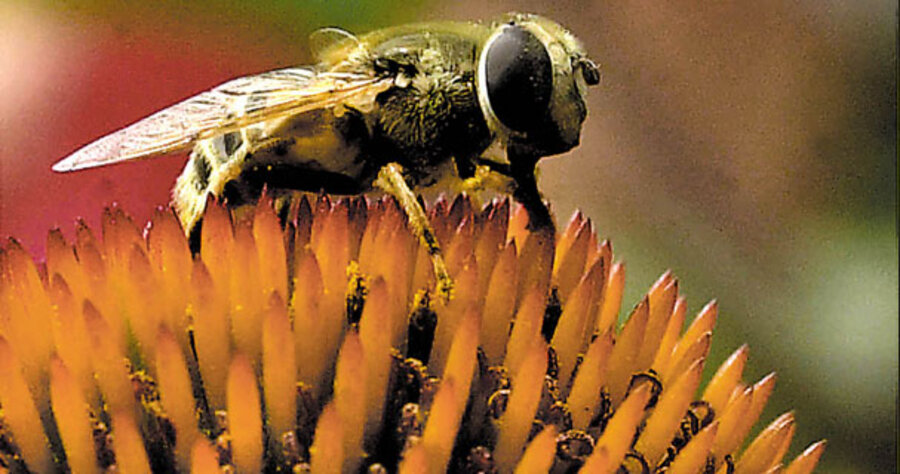What's all the buzz about?
Loading...
A bee buzzes from flower to flower. Will she choose red or pink, blue or purple? Not every flower will do.
Why do bees need flowers in the first place? Bees collect nectar and pollen from flowers as food for themselves and for the young bees in the hive.
Pollen is the fine powdery dust in flowers that is usually yellow. But some plants have red, blue, white, or black pollen. The pollen sticks to tiny hairs on the bee's body while she visits flowers. Bees comb off the pollen into pollen baskets, hollowed-out areas on both hind legs that are surrounded by stiff hairs.
Nectar is the sweet sticky liquid in a flower that's made mostly of sugar and water. Bees carry it in a special honey stomach, which lies in front of the stomach that digests a bee's own food.
When the worker bees return to the hive, the nectar they have collected will be turned into honey. Some of the nectar, however, will be mixed with pollen to form beebread, a protein-rich food used to feed young bees.
Rewarding journeys
Bees usually carry pollen from one flower species to another of the same species. This is called pollination. Pollination is a byproduct of a bee's travels from flower to flower. When bees pollinate flowers, they help flowers make seeds. Without bees to pollinate flowers, thousands species of plants would not be able to reproduce.
Worker bees go out from the hive when the weather is good to search for suitable flowers. Sometimes they fly two to three miles from the hive to collect food. They make up to a dozen trips a day, visiting hundreds of flowers.
Hive bees appear to communicate with field bees to tell them how much pollen and nectar is required. Beekeepers have observed that bees may vary the amounts of pollen and nectar carried each day, depending on the needs of the hive.
The right stuff for finding food
When it comes to finding the perfect flower, bees have four things going for them. First, they have a good sense of direction, which helps them return to the hive with no problem.
Second, they have an acute sense of smell that helps them detect a wide range of flower fragrances.
Third, bees remember. They can recognize and recall landmarks around their hives, flower patterns, and blooming schedules.
Fourth, bees have keen eyes. They can differentiate light from dark, distinguish shapes, and recognize difference in colors.
Bees see color as we do, but they can't detect the color red very well. They can see ultraviolet colors, however, which are radiation wavelengths that humans can't see. In fact, some flowers have ultraviolet nectar guides, which are markings that point bees to the nectar.
Bee garden
If you want to attract bees to your yard, these tips will help you decide how to design your own bee garden.
• Bees are attracted by scent and color. Select flowers that have a sweet aroma or a mint fragrance. Choose purple, blue, white, and yellow flowers – the colors bees can see.
• Plant the same kinds of flowers in clumps. The more flowers are planted in the same area, the more bees like it.
• Use 10 or more types of attractive plants, if you have space. Include a range of flowers of different shapes because there are many species of bees that have different tongue lengths and feed on different shaped flowers. Sunflowers are good because they are so large. Often, several species of bees can be seen at the same time on one sunflower head.
• Plant the flowers in the sun (experiments have proven that bees prefer the warmest nectar) and in places that provide shelter from strong winds.
• Don't use pesticides.
• Observe which flowers attract the most bees. Also, note the time of day that the bees visit the flowers. Some flowers make their nectar and pollen available early in the morning, while other flowers offer food later in the day.
Choosing a diversity of flowers that bloom throughout the summer, as well as in spring and fall, will support a range of bee species. In fall, bees go crazy for a plant called sedum.
For a flower that blooms very early in spring, plant crocuses. A crocus attracts bees not only for its nectar, but because of its warmth. Its petals, which are bowl-shaped, catch the sun's heat and reflect it to the center of the flower. Inside the flower, the temperature may be 10 or more degrees warmer than the outer air.
Whatever you plant, try to choose plants that are native to the area in which you live. They are more attractive to native bees than exotic flowers.
Nurture the plants and be patient. In time, the honey garden will provide the perfect flowers – even for the choosiest bees.
Red flowers are usually not pollinated by bees but by butterflies, bats, and birds (especially hummingbirds). Here's a list of a few of the flowers that do attract bees:
Anemone
Aster
Bee balm
Blackberry bush
Blanket flower
Blazing star
Blueberry bush
Dahlia
Foxglove
Geranium
Italian bugloss
Lavender
Mallow
Pincushion
Purple cornflower
Rose
[Editor's note: The original version's photo caption misidentified the insect depicted.]





